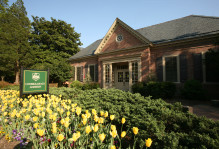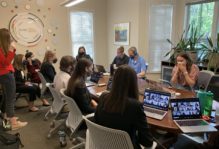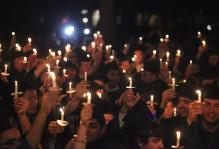William & Mary Hosts Climate Teach-in
On Wednesday, March 30th, students and speakers gathered into three rooms in the ISC to discuss issues of climate and justice as part of a Global Climate Teach-in that reached nearly a million people across 1,000 institutions including universities, schools, and nonprofits. The teach-in was started at Bard College and has since grown into a massive global event, reflecting the increasing interest and emphasis on climate justice and education as our planet undergoes the most drastic changes to our climate in several millennia.
Our hub of the teach-in was organized primarily by economics professor Dr. Sarah Stafford, with help from students and faculty from the Office of Sustainability & the Office of Community Engagement, as well as additional support from the Environment & Sustainability and Public Policy programs.
Maddy Bertagnolli ’23, who helped organize and plan the event, spoke on the importance of hosting this teach-in. “Putting on this event is important, as I think it started the conversation beyond just climate science. We talked about the larger role of injustice within climate change — how climate change impacts developing countries and communities of color more severely.”
Beginning at 7pm, the evening was split up into three sessions, each lasting an hour. The first session had three concurrent panels, one on Sea Level Rise and Social Vulnerability, another on Climate Science, and the third on Climate and Justice.
The Climate and Justice panel featured Sasikumar Balasundaram, Fernando Galeana Rodriguez, Max Blalock, and Mark Fowler, who spoke on a variety of intersectional issues surrounding how our changing climate is intertwined with justice issues.
Dr. Balasundaram, an Asian and Middle Eastern Studies professor, discussed the dire situation of climate refugees and how, due to rising tides threatening coastal cities and climbing temperatures affecting urban areas, we are seeing the greatest amount of migration due to environmental factors than ever before. Balasundaram lamented that “we increasingly have become very much a crisis management society” rather than a crisis prevention society. He presented the harrowing numbers, warning that research predicts that by 2050, there may be up to 1.2 billion climate refugees.
Dr. Galeana Rodriguez covered the issues of climate justice and Indigenous knowledge in conservation. Galeana Rodriguez, who is a sociology professor and member of the faculty for the Institute for Integrative Conservation, laid out the climate justice framework, which consists of three dimensions: distribution, recognition, and procedure. He also discussed the involvement of Indigenous voices in conservation, and how many Indigenous groups already engage in sustainable practices that ought to be adopted by the rest of the world if we want to slow the rate of the current climate crisis.
Reverend Max Blalock called for his Christian constituents to stop aiding the “destruction of creation” and pay attention to Indigenous voices who are more familiar with the intricacies of nature. Dr. Mark Fowler, a retired professor of philosophy, led us through the history of philosophical conceptions of environmental justice.
The second session, from 8 to 9 pm featured four panels: Global Climate Solutions, Climate Solutions for Energy, Food Systems and Climate Solutions, and How to Teach about Climate.
The How to Teach about Climate panel featured art & art history professor Alan Braddock, history professor and ENSP program director Andy Fisher, education professor Kathryn Lanouette, and creative writing professor Jon Pineda, discussing their unique approaches to imbuing students with an environmental education, often through non-traditional methods.
Professor Braddock showcased the environmental justice art museum (EJAM), which compiled works selected by students displaying different facets of the struggle for environmental justice. The several galleries on the EJAM’s website categorized climate justice artwork with themes such as “Ecologies of Global Migration” and “The Big Burn.”
Dr. Andy Fisher shared a personal account of why it’s so necessary to teach climate change as an issue that transcends boundaries of academic discipline. “Climate change is more than just a scientific problem, or an ecological issue,” he explained, “it is a cultural issue.”
Dr. Kathryn Lanouette, a faculty member at the School of Education, discussed the importance of creating connections between students and the subject, especially when trying to address climate change. Recent shifts in climate education have moved away from traditional science-based teaching toward supporting collective political action among students which benefits their communities.
Professor John Pineda spoke on how he teaches students to use story and narrative elements to connect with nature. In learning how to describe natural spaces and their associated emotions, he encourages students to deeply learn the intricacies of those spaces and to personally feel those emotions.
In the final session, all the participants gathered in a chemistry lecture hall to listen to Dr. Kelly Crace, District 1 Senator Monty Mason, and students Anna Lowe ’24, Corina Chang ’25, and Philip Ignatoff ’23. Calandra Waters Lake, director of the Office of Sustainability, moderated the session.
Dr. Crace addressed the mental health and well-being benefits of positive political advocacy and encouraged climate activism, and Sen. Mason gave a rousing speech on how, despite the seeming difficulties in policy-based and activism-based change, everyone’s collective political effort toward climate legislation truly matters.
In the ISC lobby, Steve Prince from the Muscarelle Museum of Art was leading an interactive art piece. He invited the teach-in participants and speakers to add an artistic representation of their thoughts on climate justice to the chalk mural, which is currently displayed in the ISC atrium.
Following the teach-in’s success, Bertagnolli seemed eager for the future of the annual teach-in on campus. “William & Mary has the opportunity to continue this in the coming years and make it a large event on our campus,” she said. “[The global teach-in] has over 1,000 colleges, middle schools, high schools, churches, and even elementary schools participate; William & Mary has joined this community” of intersectional discourse and leadership.




No comments.
Comments are currently closed. Comments are closed on all posts older than one year, and for those in our archive.